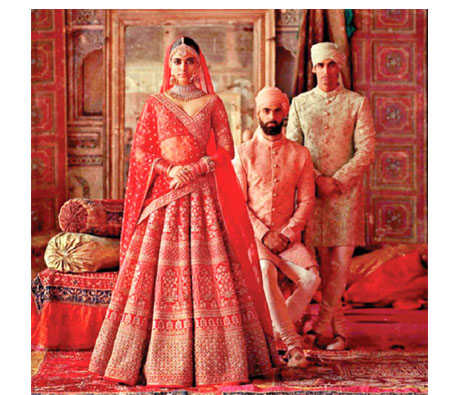Scenes from a wedding of an upper middle class Indian family. We shall stick to scrutinising the clothes. There are hardly any women in katan silk/kora silk/satin silk/khaddi georgette or any other kind of Banarasis. Kanjeevarams, Gadwals, Patolas and other luxury sarees are also conspicuous by their absence. Ideally, my eyes still search for these go-to-drapes in weddings here, considering they are heritage weaves showcasing the history of the handloom craft of Bharat that women should flaunt. Till a few years ago, at least, that would have been the case with these versatile six yards, which would be aired again for other special functions. The stigma of ‘repeat’ wouldn’t have become such a social plague.
But can we say that about weddings and celebratory events today? For instance, the wedding I mention has the bride in a heavily encrusted synthetic lehenga (stuffed with grotesque cancun) that weighs thrice as her. Looking positively tired with what is hung on her lithe frame, she bearly enjoys the pheras because walking with all that weight needs practice. The bride’s mother barely smiles while greeting the guests in another laborious lehenga instead of an ethereal jamevaar or tanchoi. The bride’s sister is forced to take off her jewellery when everyone is distracted during the havan since she cannot get rid of her Manish Malhotra monstrosity.

Funnily, with all the effort women put into channelling the Bollywood bridal (more like chandeliers) look these days, I wonder whether they realise how wasteful their purchases are. They clearly won’t muster the courage to get into those ‘clothes’ again. But, if these were handwoven or handcrafted luxury sarees, the case would have been different. This is where we must understand how the priorities shifted. Why have the brides and their families shunned Bharat’s textile and crafts heritage to adopt a severely consumerist and commercial trope that is extremely unsustainable anyway? How has Bollywood’s glorification of celebratory wear and the permeation of Western theories in the Indian mainstream market jeopardised the position of Indian heritage luxury wear amongst its own people.
The Western construct of USE and Throw
Celebrities might not spell it out in that many words but the consumerist model of use and throw is constantly being peddled through their work and social media handles that are followed en masse. Celebrities do not repeat their clothes, which send a signal to youngsters and their parents that they should take the cue. Considering that Indian heritage weaves and crafts are thoroughly versatile and can be styled in a plethora of ways, celebrities would never glorify them because for them it’s all about encouraging heavy consumption. In that context, popularising garish, clumsy lehengas in weddings through PR machinery, film and fashion narratives also serves the purpose of ‘wear once and discard’ because in their sane minds no one would think of repeating these products. Call it a status symbol or wasteful behaviour, millennials are being tutored to splurge on poor quality clothes they will not cherish. Contrast this with the heirloom sarees our ancestors owned or how they took care of them and you will understand this point.
If we refer to films such as Govind Moonis’ Nadiya ke Paar, we would observe how Hindi films could have taught better if their heart was in the right place. In this Rajshri Production classic, the mother of the bride wears katan silk Banarasis for both the marriage ceremonies. The brides are in their Banarasi beauties, too. The sister dons a gotapatti and zardozi silk lehenga choli. At a time I find women cribbing about luxury weaves being unaffordable (while splurging on disgusting fast fashion). Here is a reminder of how women in villages, too, wore India’s heritage weaves when they had to dress up. Such films showcased luxury weaves testifying how grand and versatile Bharatiya handloom textiles occupied pride of place in wardrobes of women across different stratas of society. Everything locally made, carrying the stamp of the region and used by Indians only. And yet, Hindi cinema post Raja Hindustani shunned this handmade luxury and adopted a completely imbalanced formula. Why did we let the West, the synthetics, the Karan Johars and Manish Malhotras usurp and destroy it all?The local crafts, weaves, markets, the textile economy… Were the communists that cunning or were we extra gullible?
The Karan Johar brand of wedding wear in cinema
The nouveau riche swear by garbled Bollywood fashion that has, over the years, distorted the way the ‘khaandani’ actually dress in Punjab (considering Karan Johar has always peddled a distorted Punjabi wedding narrative in his cinema). Remember the scene in Dilwale Dulhania Le Jayenge where a weaver comes home to sell sarees during the run up to Simran’s Shaadi? He throws stunning luxury Banarasis on the bua exclaiming, Kya khil rahihain aap! which proves textiles/crafts were preferred by all sections of people in Indian towns and villages till even a few years ago, especially for occasion wear. The excessive bling began with Kuch Kuch Hota Hain where Johar signed Malhotra after he styled Karishma Kapoor in Raja Hindustani. The urbanites bore the brunt of bad influence after that. The rot has travelled so far and wide that in all North Indian weddings today, this is the overhyped look that gets carried because it is considered the ‘in thing’. Johar probably engineered this flawed Punjabi wedding culture so that his designer coterie could market their impractical ware (that are never used again) through celluloid.
Destroying Diversity of Indian Wedding Wear
Even though designers like Sabyasachi Mukherjee spun a narrative of Indian wear amongst his international clientele and ensured it caught the fancy of the world when actors like Anushka Sharma, Ranveer Singh, Deepika Padukone wore his creations in their weddings, it led to the creation of a boring (uniform) moldboard for all to follow. This was detrimental to the local luxury weaves and crafts of different Indian States.

Considering that Indian heritage weaves and crafts are thoroughly versatile and can be styled in a plethora of ways, celebrities would never glorify them because for them it’s all about encouraging heavy consumption
Weddings of every State have an identifiable charm and that is because of the traditions, rituals followed as well as the clothes and jewellery worn. Be it Banarasis in West Bengal and UP, Gota Patti on silk poshaks in Rajasthan, phulkari on silk at Punjabi shaadis, Kanjeevarams in Tamil Nadu, Molakalmurus in Karnataka or Assam paat silks in Assam, Indian brides carry a distinct look in their weddings that boasts of luxury weaves and crafts of their respective states. Sabyasachi ensured he made all brides carry a tried and tested look that got stamped as being popular.
Exposing the Communist agenda
Why are there chinks and cracks in the Bollywood armour? Because, the Hindu who is proud of his/her culture and heritage has woken up from slumber and called out the hypocrisy prevalent in the industry. Fed up of the anti-Hindu and anti-Indian diatribe for so many years he/she has lashed out and held the Islamist/Socialist/Communist perpetrators accountable realising how this germ eats into the fabric of a prosperous society. In the weaves and crafts industry, too, so called textile activists built fancy castles preying on the poverty of weavers and artisans.
But these parasites are irrelevant now. Let’s shift to where even those not prescribing to the left liberal ideology is going wrong. They are ignoring economical dynamics. Bollywood producers are now strategizing on how to bring the audience back to the theatres because money matters. Only a naïve will think, “Areysirf entertainment hain, is meinitna mat socho!” Then you don’t know how impactful a medium cinema is. Similarly, politics sirf politics nahi, humara future uss se juraahua hain. Kapdeya saree sirfkapdeya saree nahihain, humara indigenous industry hain, jo humaarein Hindu raja raani ne banayi, auraapkelaaparwahikewajaah se sab Mughaloya Chinese kenaam ho gayihain. If authentic Indian weaves and crafts don’t get enough patronage, the narrative will shift towards synthetics that the left cabal would want because it would pull back the local Indian economy. The #vocalforlocal movement requires a script that abolishes fakes and establishes the importance of authentic history of our heritage. If there is economic, conscious and political weakness in all aspects (the weaves and crafts sector be counted in), slavery to external forces is evident. It is about time we recognise this and act.
Any fashion enthusiast based in West Asia would tell you how fascinated the Middle East is with Indian wear. But ask for names and they would go gaga about designers like Manish Malhotra, Sidharth Tytler, Falguni and Shane Peacock, Neeta Lulla and so on, instead of talking about India’s heritage weaves and crafts that better labels work with. Even though designers like Sabyasachi Mukherjee spun a narrative of Indian wear amongst his international clientele and ensured it caught the fancy of the world when celebrities wore his creations in their weddings, it led to the creation of a boring (uniform) moodboard for all to follow. This was detrimental to the local luxury weaves and crafts of different Indian states.














Comments